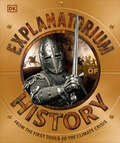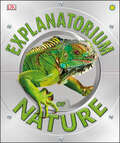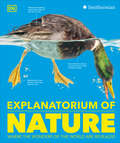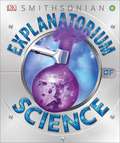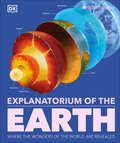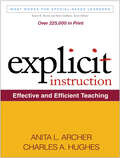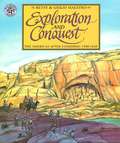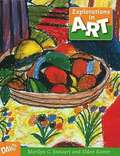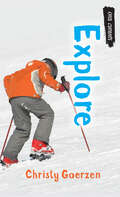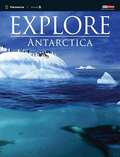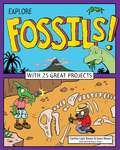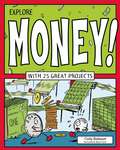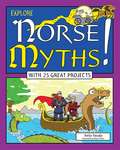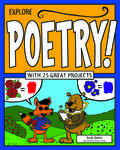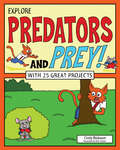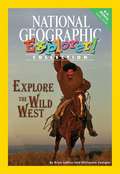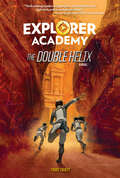- Table View
- List View
Experiments with Plants: A True Book
by Salvatore TocciNine easy-to-follow experiments help readers explore what a plant is, what it needs to grow and live, what's inside a plant seed, and how seeds grow and get spread in the wild.
Experiments with Plants: Student Investigations
by National Science Resources CenterNIMAC-sourced textbook
Explanatorium of History: From the First Tools to the Climate Crisis (DK Explanatorium)
by DKDiscover the story of &“us&” — from the dawn of human history up to the world we live in today.This visually stunning history encyclopedia for children takes you on an epic fact-packed journey through the past. Explore historical events through vivid illustrations and engaging explanations.Inside the pages of this fascinating history book for kids ages 10-14, you&’ll find: • Gorgeous images of objects, paintings and landscapes that bring history to life. • In-depth information using targeted captions and annotation. • Supporting artwork panels allow for a deeper understanding. • Comprehensive historical reference. Welcome to the SI Explanatorium. Take a look inside to reveal how history works! From the evolution and migrations of early humans to the rise and fall of great empires like Ancient Rome and the Aztecs, this history reference book shows you the major turning points in history.Get the inside track on wars and conflict, including European knights, Japanese samurai, Inca warriors and the major clashes of World War I, World War II, the Cold War, the War on Terror and so much more. It&’s the perfect children&’s visual encyclopedia for young history buffs.There are more SI Explanatoriums to explore! Get closer to nature than you&’ve ever been before with SI Explanatorium of Nature and see the world of science come to life with SI Explanatorium of Science.
Explanatorium of Nature (DK Explanatorium)
by DKGet closer to nature than you&’ve ever been before with this jaw-dropping guide to our wonderful world. Marvel at the breathtaking photography showcasing flora and fauna in the most incredible, intricate detail. From ants to elephants, the animal kingdom is explored and explained in this extraordinary encyclopedia that puts you at the heart of the action. See the tiny spines on a stinging nettle, watch lichen spreading over a tree, and observe the secret suckers on an iguana&’s feet. The mysteries of the natural world are displayed in brand new images, together with cross-sections, macro, and electron microscope images. Alongside the utterly absorbing visual content, Explanatorium of Nature brings its own fountain of knowledge about how nature works. For instance, did you know baby foxes that are born with blue eyes turn to gold? Or that reptile scales are made from the same material as your fingernails? Discover how spiders spin webs, how birds fly, how snakes kill, and much, much more. This irresistible book is a guaranteed favorite for animal lovers, nature enthusiasts, and budding wildlife experts everywhere.
Explanatorium of Nature: Where the Wonders of the World are Revealed (DK Explanatorium)
by DKGet closer to nature than you’ve ever been before with this jaw-dropping guide to our wonderful world. Marvel at the breathtaking photography showcasing flora and fauna in the most incredible, intricate detail. From ants to elephants, the animal kingdom is explored and explained in this extraordinary encyclopedia that puts you at the heart of the action. See the tiny spines on a stinging nettle, watch lichen spreading over a tree, and observe the secret suckers on an iguana’s feet. The mysteries of the natural world are displayed in brand new images, together with cross-sections, macro, and electron microscope images. Alongside the utterly absorbing visual content, Explanatorium of Nature brings its own fountain of knowledge about how nature works. For instance, did you know baby foxes that are born with blue eyes turn to gold? Or that reptile scales are made from the same material as your fingernails? Discover how spiders spin webs, how birds fly, how snakes kill, and much, much more. This irresistible book is a guaranteed favorite for animal lovers, nature enthusiasts, and budding wildlife experts everywhere.
Explanatorium of Science
by Smithsonian Institution DkOpen up this book to reveal how science really works! Watch as mixtures merge and matter changes state. Discover how some chemical changes can be reversed, yet others can't, and why some reactions produce a bang! See bacteria at work in the world around us, and even inside the human digestive system. Understand the tricks that light plays and unlock the secrets of electricity to find out how it powers your home.
Explanatorium of the Earth (DK Explanatorium)
by DKWelcome to the Explanatorium of the Earth - the only Earth encyclopedia for children you'll ever need, with amazing photographs of everything from supervolcanoes to tsunamis.What makes volcanoes erupt? Why are tornadoes and hurricanes so destructive? How do rocks, fossils, and gems form? Explanatorium of the Earth takes you on an incredible voyage deep into the heart of our planet and back to discover the powerful forces that continually shape and remodel our ever-changing world. Discover how tectonic plates tear apart and collide, moving inch by inch to create continents, mountain ranges, oceans, and volcanoes. Witness the destructive power of earthquakes, tsunamis, and hurricanes. Learn how the slow but relentless process of erosion and weathering wear away rock, reducing mountains to dust and carving valleys and canyons into the land. And learn how the living world and rock cycles have worked together for millions of years to stabilize the planet's climate, keeping Earth suitable for life.
Explicit Instruction: Effective and Efficient Teaching (What Works for Special-Needs Learners)
by Anita L. Archer Charles A. HughesExplicit instruction is systematic, direct, engaging, and success oriented--and has been shown to promote achievement for all students. This highly practical and accessible resource gives special and general education teachers the tools to implement explicit instruction in any grade level or content area. The authors are leading experts who provide clear guidelines for identifying key concepts, skills, and routines to teach; designing and delivering effective lessons; and giving students opportunities to practice and master new material. Sample lesson plans, lively examples, and reproducible checklists and teacher worksheets enhance the utility of the volume. Purchasers can also download and print the reproducible materials for repeated use. Video clips demonstrating the approach in real classrooms are available at the authors' website: www.explicitinstruction.org. See also related DVDs from Anita Archer: Golden Principles of Explicit Instruction; Active Participation: Getting Them All Engaged, Elementary Level; and Active Participation: Getting Them All Engaged, Secondary Level
Exploding Ants
by Joanne SettelA wasp lays its eggs under a caterpillar's skin so that its young can eat the caterpillar's guts as they grow. A young head louse makes its home on a human hair and feasts on human blood. Frogs use their eyeballs to help swallow their food. From small worms that live in a dog's nose mucus to exploding ants to regurgitating mother gulls, this book tells of the unusual ways animals find food, shelter, and safety in the natural world. If animals all ate the same things and lived in the same places, it would be impossible for all of them to survive. So they specialize. Some animals eat the bits that others leave behind, such as skin and mucus. They find all kinds of unusual places to shelter, including the cracks and holes in another creature's skin or its internal organs. They use their own bodies to protect themselves from predators by imitating unsavory items such as bird droppings and even by blowing up. These habits that may seem disgusting to us are wonderful adaptations that make it possible for a great variety of creatures to live and thrive on Earth. Read about them and marvel at the amazing ways animals adapt to the natural world.
Exploration And Conquest: 1500-1620
by Giulio Maestro Betsy MaestroChristopher Columbus was not the first to discover the Americas, but his voyages led to European exploration of the New World. Rich in resources and natural beauty, the Americas were irresistible to gold-hungry conquistadors. The newcomers gave little thought to those who had called the lands their home, and exploration soon came to signify conquest. The New World -- and the lives of its inhabitants -- would be changed forever.
Explorations in Art [Grade 5]
by Eldon Katter Marilyn G. StewartIncludes six units, each organised around a universal theme relevant to students' lives; these themes foster meaningful connections to artworks across time and place. This book also features elements and principles that are embedded throughout each unit to ensure continual application and understanding.
Explore (Orca Currents)
by Christy GoerzenWhen Mike Longridge gets himself in trouble yet again, he is given a choice: juvenile detention or an outdoor program called Explore. He opts for Explore, but soon finds himself wondering how he is going to survive ten months with the hippies and keeners in the program. He's never felt so out of place and is certain he will never get the hang of the outdoor activities. Will Mike go back to his old trouble-making ways or will he finally find a place to belong? This short novel is a high-interest, low-reading level book for middle-grade readers who are building reading skills, want a quick read or say they don’t like to read! The epub edition of this title is fully accessible.
Explore Fossils!
by Cynthia Light Brown Grace BrownIn Explore Fossils! With 25 Great Projects, readers can expand their dinosaur obsessions into learning opportunities that take them beyond Triceratops, Stegosaurus, and even Tyrannosaurus rex to other animals, plants, and microbes that lived long before humans. Explore Fossils! introduces young readers to the history of life on Earth as revealed by fossils. Kids learn how fossils form and about the different types of fossils and the world of long ago--its landscape and the plants and animals that lived then. Scientists use radiometric dating to test fossils to discover when they were made, what organisms made them, what those organisms used for energy, what killed them, and a whole lot of other information. All from rocks! That's a lot of information stored under our feet. Activities include creating plaster fossils, using popcorn to illustrate radiometric dating, and exploring what might have caused mass extinctions by making a lava flow and simulating an asteroid impact. By studying the past, not only do students meet amazing plants and animals, they are also encouraged to consider their own role in geological time to make thoughtful hypotheses about the future.
Explore Money!
by Bryan Stone Cindy BlobaumIn Explore Money! With 25 Great Projects, money is more than something to earn, save, and spend. It's an opportunity to explore history, art, science, economics, and math! While checking out the change in their pockets and bills from their banks, young readers search for hidden treasures, learn how money can multiply, and see how countries keep their currency secure. Very large and very small numbers take on a new relevance when seen through the lens of money. Using familiar materials found in the home or classroom, young readers explore the cultural aspect of money as well as its physical properties, discovering how these properties have affected business and global relationships throughout history. Kids experiment with various substances to clean coins, scientifically test coin components, design their own currency, and plan how to allocate their own money. Understanding the whats, whys, and hows of currency helps children achieve financial literacy and establish a strong foundation for a healthy, life-long relationship with money. Explore Money! meets Common Core State Standards for literacy in language arts, and mathematics; Guided Reading Levels and Lexile measurements indicate grade level and text complexity.
Explore Norse Myths!
by Anita YasudaThe stories of Norse myths and legends are a terrific introduction to Viking culture, history, science, and traditions, which thrived in Scandinavia from the eighth to the eleventh centuries. But who were the Norse, who left their homelands in Denmark, Norway, and Sweden to trade, raid, and explore around the world? In Explore Norse Myths! With 25 Great Projects, young readers discover the remarkable people and mythical creatures of old. Learning about Norse myths means unearthing the origin of Viking beliefs, as well as exploring their ships, tools, and other technology that flourished for nearly 450 years. Along the way, kids will read how Norse myths helped explain the natural world from thunder to the seasons, from creation to death. They may be surprised at how Norse myths continue to influence modern culture in the form of movies and books, including the new series by Rick Riordan. Readers will read Norse stories and learn about the adventures of real Norse explorers, including Erik the Red and Leif Erikson. Through a mixture of fun facts, trivia, jokes, comics, and hands-on activities, kids will dig up Scandinavia's past and sail the seas along with the gods and giants in Explore Norse Myths!
Explore Poetry!
by Andi DiehnPoems can be silly, serious, or fun, just like kids! Whether it’s the sing-song rhythm of a limerick, the serendipitous magic of a found poem, the deceptive simplicity of a haiku, or the easy familiarity of an acrostic poem, children are charmed by poetry. And what’s more fun than reading poetry? Writing it! In Explore Poetry! With 25 Great Projects children have fun learning about different forms of poetry while delving into different literary techniques such as personification, metaphor, and alliteration, all of which are discussed in a simple and accessible way. Activities include creative writing exercises designed to reinforce language arts skills, plus art projects that encourage children to visualize concepts and definitions. Short biographies of important poets reinforce the concept of poetry as an important part of society. Explore Poetry! meets Common Core State Standards for language arts; Guided Reading Levels and Lexile measurements indicate grade level and text complexity. Informational and inspiring, Explore Poetry! fits seamlessly into the poetry curriculum of grades 2 to 4 and serves as an enrichment resource all during the school year, especially April, Poetry Month.
Explore Predators And Prey
by Cindy BlobaumHunting, hiding, trapping, and tricking are just a few of the strategies used by animals in the wild to ensure they eat enough without being eaten themselves! In Explore Predators and Prey! With 25 Great Projects, readers ages 7 through 10 explore the physical and behavioral adaptations of predators and prey and their impact on the environment. Predators, such as hawks and foxes, have keen eyesight and sharp beaks and teeth to help them catch their prey. Prey, such as mice and rabbits, have large ears to hear danger and can move quickly to escape their enemies. Animal populations are closely integrated with each other and the surrounding environment. A change to one population causes changes to all others. Readers discover how repercussions can affect nature, including humans, and are encouraged to consider their own actions with an eye toward the effect on the environment. In Explore Predators and Prey, kids actively learn about body tools and behavior strategies as they test their own abilities to hunt and hide in a series of science-minded activities. Fun facts and colorful cartoons make learning entertaining and links to online primary sources and videos make the content accessible to all learners.
Explore Predators and Prey!: With 25 Great Projects
by Cindy Blobaum Matt AucoinHunting, hiding, trapping, and tricking are just a few of the strategies used by animals in the wild to ensure they eat enough without being eaten themselves! In Explore Predators and Prey! With 25 Great Projects, readers ages 7 through 10 explore the physical and behavioral adaptations of predators and prey and their impact on the environment.Predators, such as hawks and foxes, have keen eyesight and sharp beaks and teeth to help them catch their prey. Prey, such as mice and rabbits, have large ears to hear danger and can move quickly to escape their enemies. Animal populations are closely integrated with each other and the surrounding environment. A change to one population causes changes to all others. Readers discover how repercussions can affect nature, including humans, and are encouraged to consider their own actions with an eye toward the effect on the environment.In Explore Predators and Prey, kids actively learn about body tools and behavior strategies as they test their own abilities to hunt and hide in a series of science-minded activities. Fun facts and colorful cartoons make learning entertaining and links to online primary sources and videos make the content accessible to all learners.
Explore the Bible: The Life of Christ Student Textbook
by Purposeful DesignThis book helps students explore Jesus' life through 40 individual lessons incorporated into a student textbook.
Explore the Salish Sea: A Nature Guide for Kids
by Joseph K. Gaydos Audrey DeLella BenedictFilled with beautiful photography and engaging text, Explore the Salish Sea inspires children to explore the unique marine ecosystem that encompasses the coastal waters from Seattle's Puget Sound up to the Strait of Juan de Fuca and the Georgia Strait of British Columbia.Discover the Salish Sea and learn about its vibrant ecosystem in this engaging non-fiction narrative that inspires outdoor exploration. Filled with full-color photography, this book covers wildlife habitats, geodiversity, intertidal and subtidal sea life, and highlights what is unique to this Pacific Northwest ecosystem.
Explorer Academy: The Double Helix (Explorer Academy)
by Trudi TrueitThe mystery deepens and the action intensifies for 12-year-old Cruz Coronado and friends in the exciting third book in the Explorer Academy series.The adventure continues for Cruz, Emmett, Sailor, and Bryndis as they continue their studies at sea and travel to exotic locations around the world. A mysterious person alerts Cruz to impending danger while he and a few trusted pals explore ancient ruins in Petra, Jordan, and search for another piece of the puzzle his mother left behind. Worst of all, now his father has gone missing, which prompts Aunt Marisol, his number one protector, to leave the ship in search of him. Who is the new professor who takes her place? How does the new technology he introduces help or hurt Cruz's quest? Why is Nebula determined to stop Cruz before he turns 13? The clock is ticking as his first teen birthday draws near ... a milestone that will change his life forever, one way or another.

